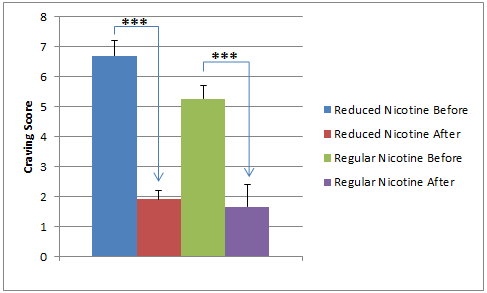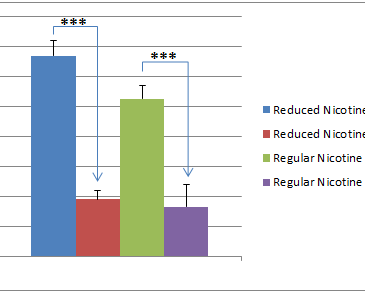In the continuous battle against the negative effects of cigarettes, both on smokers and bystanders, science and technology have given us a number of alternatives to the classic nicotine cigarette, such as the nicotine free, electronic cigarette. However, it is unclear if these alternatives successfully curb smoking cravings. This week’s ASHES reviews a study by Domino and colleagues (2013) that compared the effects of regular and reduced nicotine cigarettes on self-reported craving and release of striatal dopamine, a neurotransmitter involved in the brain’s reward pathway.
Methods
- The researchers initially recruited 24 male tobacco-dependent participants using newspaper ads and word-of-mouth. From those they excluded potential participants who met criteria for any other substance use disorders, leaving 22 participants.
- Under single-blind conditions and after overnight abstinence, participants smoked two reduced-nicotine (.08mg nicotine) followed two hours later by two average-nicotine (1.01mg nicotine)
cigarettes. - Researchers mapped the effects of smoking both kinds of cigarettes on the brain’s reward pathway using positron emission tomography (PET) scans.
- Participants rated their level of craving on a scale from 1 to 10 (i.e. “not at all” to “most ever”) before and after smoking each type of cigarette.
Results
- Both types of cigarettes activated the dopamine (DA) reward pathway in the brain.
- Reduced-nicotine cigarettes released DA primarily in the right striatum while regular nicotine cigarettes released DA bi-laterally but more heavily in the left striatum.
- Despite this difference, as Figure 1 shows, smoking reduced-nicotine cigarettes reduced self-reported craving as much as smoking regular nicotine cigarettes.
- This finding suggests that the DA reward pathway, originally thought to be activated in response to ingesting specific drugs, may, in fact, be a general addiction-related response
triggered by more than the specific chemical in question.
- This finding suggests that the DA reward pathway, originally thought to be activated in response to ingesting specific drugs, may, in fact, be a general addiction-related response

Figure. Average craving scores as affected by reduced nicotine and regular nicotine cigarettes. Adapted from Domino et al, 2013. Click image to enlarge.
Note: *** p < .001
Limitations
- The sample size was small and exclusively male, limiting the power of the study and the generalizability of results.
- The researchers did not randomize the order of type of cigarette used, so satiation of the craving may have been because participants were smoking something after abstinence, even if
it was reduced nicotine.- It is possible that the regular nicotine cigarettes would have reduced craving even more if they had come first.
Discussion
The results of this study support the idea that there is a non-pharmacological (non-nicotine) component to cigarette addiction. The effects on the dopamine reward system were originally thought to be associated with the nicotine released during smoking (as reviewed by Sharma & Brody, 2009). The current study suggests that smoking both regular cigarettes and reduced-nicotine cigarettes reduces self-reported craving and releases striatal dopamine. Further studies are necessary to determine whether these effects translate into smoking cessation and relapse prevention among those who turn to reduced-nicotine or non-nicotine alternatives in order to stop smoking.
– Emily Shoov
References
Domino, E. F., Ni, L., Domino, J. S., Yang, W., Evans, C., Guthrie, S., Wang, H., Koeppe, R. A., Zubieta, J.-K. (2013). Denicotinized Versus Average Nicotine Tobacco Cigarette Smoking
Differentially Releases Striatal Dopamine. Nicotine & Tobacco Research, 15(1), 11–21.
Sharma, A., & Brody, A. L. (2009). In vivo brain imaging of human exposure to nicotine and tobacco. Nicotine psychopharmacology, handbook of experimental pharmacology, 192, 145-171.
What do you think? Please use the comment link below to provide feedback on this article.




